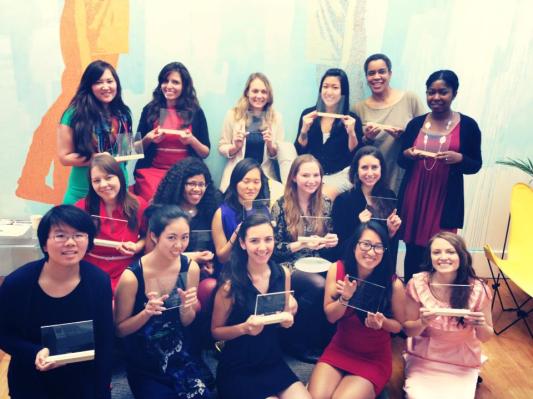Amidst all the arguments about “brogrammer” culture and the presence of women in Silicon Valley, here’s a company that’s actively working to change things, albeit on a small scale (for now) — Hackbright Academy, which describes itself as “a 10 week training program designed to help women become awesome programmers.”
The academy just graduated its 16-person second class (that’s a photo of graduation day to the left). Graduation comes shortly after career day, so it’s probably too early to talk about how many of the recent graduates actually get jobs, but co-founder David J. Phillips (who also co-founded location startup Banjo) shared some earlier data. Eight out of 12 students in Hackbright’s first class, were looking for immediate employment, he said, and all eight of them got offers from companies like New Relic, Survey Monkey, Cisco, and Bump.
Unlike his co-founder Christian Fernandez (who has a B.S. in computer science and electrical engineering, and who worked at Ace Monster Toys, Kivera, Ask, and Fuzebox), and their first instructor/”hacker in residence” Charles Ruhland (whose experience includes roles at Klout and Salesforce, and who has a B.S. in computer science), Phillips didn’t grow up coding or study computer science in college. Instead, he learned to code in an informal program taught by Fernandez — Hackbright is both a continuation of that program and a corrective, since only three of the 21 participants were women.
Hackbright is currently based in San Francisco’s Mission District, although Phillips said it’s moving to a larger location in Union Square. The first half of the program focuses on teaching the fundamentals of web development, starting with Python and moving on to other topics like Flask, Django, JavaScript, HTML, and CSS, and incorporating plenty of guest lectures. Then in the second half each student works on a personal project.
Turning someone into a professional programmer in less than three months seems awfully ambitious, and Phillips acknowledged that there’s been some skepticism among recruiters. On the other hand, the stats above suggest that the program is working. It helps that Hackbright students usually aren’t starting from scratch, but have instead developed their initial skills using Codecademy or by attending development workshops. After all, Phillips said, Hackbright is for people who are serious about programming as a profession, and you can’t decide that you’re serious until you’ve tried it out.
Zoe Kay, for example, told me that after a year of AmeriCorps and some time doing temp work, she was trying to settle on a career — web development seemed like an option since her boyfriend and his friend both worked in the field and seemed to enjoy their work. Kay already had a few months of Codecademy under her belt when she interviewed to participate in Hackbright’s first class. (She did the interview from Thailand, while traveling around the world, and started class two days after she returned to the United States.)
Kay described Hackbright as an intense but fun environment. (“I found that I got hungry much quicker than I expected.”) The difficulty of the exercises ramped up quickly on the first day, she recalled, prompting her to think, “Oh my God, I’m never going to survive the 10 weeks.” But she survived and graduated, and is currently working as an intern at New Relic, and starts as a full-time engineer next month.
A big part of the Hackbright experience, she said, was the support that the students gave each other — and yes, the all-female composition affected the experience.
“Once I got in, I noticed a difference for myself because I’m kind of quiet,” she said. “I like to be really sure of my ideas before I talk about them. It’s not like all women are like that, or that men aren’t like that, but I find that there are a lot of similarities between women. So it was a really supportive environment. … We had really good rapport.”
Given the short timeframe, Hackbright didn’t have time to cover every topic in depth, Kay acknowledged, but “it was enough to get comfortable with them.” She noted that when New Relic hires developers, it’s looking for “someone who has the right mindset.”
“They don’t expect you to know everything,” she said. “Even seasoned engineers are learning new things.”
Now Phillips is hoping to expand the program, which he’s currently running as a bootstrapped startup. The plan is to bring on more students for the next class, assuming Hackbright can recruit enough instructors to maintain its eight-to-one student-to-teacher ratio. He said he’s also interested in expanding into other geographies, though it sounds like that’s not an immediate priority. But however Hackbright expands, Phillips said it will continue to focus on teaching women exclusively.
“I think going into it we didn’t realize how powerful it would be to do something like this,” he said. “Right now, with the very small number of women in tech, if we can increase the ratio, that’s better for companies, better for productivity, better Silicon Valley, better for consumers. … There are people who hear about us who start considering software engineering as a career, when they never did before.”
Hackbright is currently accepting applications for its next class. The deadline is January 15, with a start date of March 4. The program costs $7,500, but if you get hired afterward, then Hackbright will use part of its recruiting bonus to refund your tuition.
